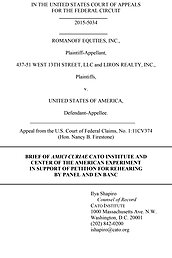Romanoff Equities, Inc. v. United States
Learn more about Cato’s Amicus Briefs Program.
Should a federal court in Washington be guessing what common-law property rights a person has in New York, when there is a procedure in place that allows the federal court to ask the state’s highest court what the state law actually is? In Romanoff Equities v. United States, that’s exactly what the Court of Federal Claims (CFC, a special court that deals with monetary claims against the federal government) did, a “guess” that was subsequently affirmed on appeal. The Romanoffs, as predecessors-in-title to a 1932 common-law right-of-way easement, had granted New York Central Railroad the right to “construct, operate and maintain” an elevated viaduct for the purpose of removing trains from pedestrian traffic in New York City. By the 1980s, however, the railroad no longer maintained the structure and, under the terms of the easement, the land and title were to revert to the Romanoff family. But the City of New York — wanting to convert the abandoned railroad viaduct into a recreational area (the High Line) that now includes taco trucks, salsa dancing, stargazing, retail shops, and other activities entirely unrelated to operating a railroad — asked the federal government to invoke the National Trails System Act and convert the easement into a public park. The federal government granted the request, so the Romanoffs filed a lawsuit, arguing that converting the railroad right-of-way into a public park is a compensable taking under the Fifth Amendment. The Justice Department argued, and the CFC agreed, that the government’s conversion of the easement was not a taking because New York property law recognizes an “easement for anything” (!), allowing the City to use the property however it liked in perpetuity. The Romanoffs took their case to the U.S. Court of Appeals for the Federal Circuit — a court of national jurisdiction that handles certain special appeals, including from the CFC — asking for “certification” to the New York Court of Appeals (the state’s highest court) for a proper interpretation of the easement. They argued that New York courts have never recognized an “easement for anything” and federal courts shouldn’t be inferring one. The Federal Circuit’s three-judge panel ignored the Romanoffs’ request that the court send the question to the state judiciary and instead upheld the CFC’s guess as to how a New York court would construe the easement. The Romanoffs have now petitioned the Federal Circuit to hear the case en banc (all the judges on the court). In an amicus brief supporting that petition, Cato argues that novel or unsettled questions of state law, as in this case, should indeed be sent to a state’s highest court. When the Federal Circuit refused to certify the legal issue here, it made new law for the state of New York, violating principles of judicial federalism. This case also has enormous consequences for property owners who have to litigate their constitutional claims in the CFC, a court of national jurisdiction. There are vast differences in how individual states treat property rights. Federal judges in Washington — who (understandably) have little familiarity with this varied jurisprudence — should not be fashioning state law with no basis in state-court precedent.



